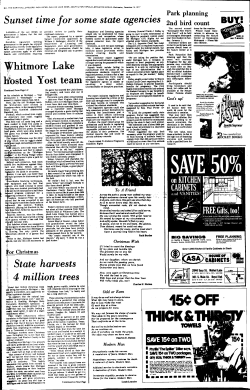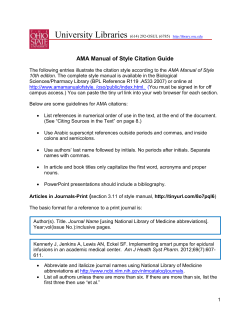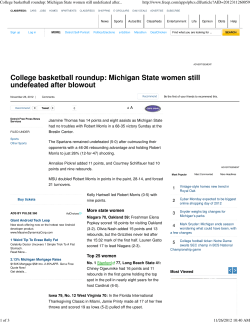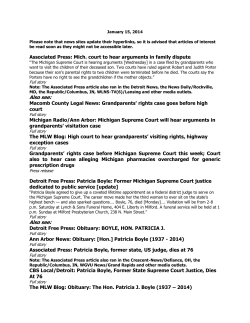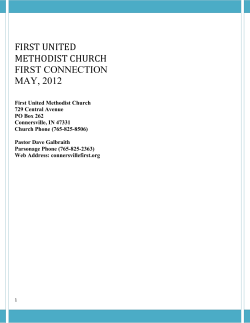
T Guy Beckley: Anti-Slavery Crusader
Guy Beckley: Anti-Slavery Crusader By Susan Goss Johnston T he Reverend Guy Beckley’s death was reported on the first day of 1848 in Ann Arbor’s abolitionist newspaper, the Signal of Liberty.1 This was not the usual abbreviated death notice. It was the newspaper’s farewell to one of its founders. Although mention was made of his birth and his family, no names and few details were provided. Instead, the newspaper focused on Beckley’s life and the events that led to the founding of the Signal of Liberty itself. One seldom has a window into the thoughts of a person long dead. The Signal of Liberty provided Guy Beckley a platform from which to preach during his life. It remains his voice today. The Itinerant Minister Guy Beckley began his career in 1827, at the age of 22, when he was admitted on trial to the New England Methodist Conference. For this training mission, he was paired with William McCoy, and assigned to Rochester in the Vermont District.2 He was ordained a deacon in 1829 and elected and ordained an elder of the Methodist church in 1831. During his time as an itinerant Methodist minister, he served in Rochester, Unity, Goshen West River, Newfane, Wardsboro, and Brattleboro, all in Vermont, and in Keene and Winchester, New Hampshire.3 The American Anti-Slavery Society Agent In 1836, Beckley located, probably at his own request.4 He had been asked that year to become an agent of the American Anti-Slavery Society, and accepted an appointment 1. "Another Laborer Departed!" Signal of Liberty (Ann Arbor, Michigan), 1 January 1848, p. 2, col. 1; digital images, Ann Arbor District Library, The Signal of Liberty Newspaper (http://signalofliberty. aadl.org/ : accessed 29 May 2013). 2. Minutes of the Annual Conferences of the Methodist Episcopal Church for the years 1773-1828, (New York: T. Mason and G. Lane, 1840), 1: 531-533; digital images, GoogleBooks (http://books.google.com/books?id=WgVMAAAAYAAJ : accessed 3 February 2014). Carol Mull states that Guy Beckley studied at the Andover Theological Seminary, but his name does not appear on published student lists of that school. It’s likely that his education was an apprenticeship. Carol E. Mull, The Underground Railroad in Michigan (Jefferson, N.C.: McFarland & Co., 2010), Kindle edition, chapt. 4; Triennial Catalogue of the Theological Seminary, Andover, Mass. (Andover: Warren F. Draper, 1870); digital images, Internet Archive (https://archive.org/details/triennialcatalog00ando : accessed 3 February 2014). 3. Minutes of the Annual Conferences of the Methodist Episcopal Church for the years 1829-1839, (New York: T. Mason and G. Lane, 1840), 2: 27, 107 GoogleBooks (http://books.google.com/books? id=PtIYAAAAYAAJ : accessed 3 February 2014). 4. Ibid., 2: 389; Charles Yrigoyen Jr. and Susan E. Warrick, Historical Dictionary of Methodism (Lanham, Md.: Scarecrow Press, 2005); GoogleBooks preview only (http://books.google.com/ books?id=sIAY_J8mHKAC : accessed 5 February 2014); by “locating,” a minister leaves the itineracy. This can be at his own request, or he can be deemed unable to itinerate and be forced to locate. Guy Beckley: Anti-Slavery Crusader from that organization’s executive committee in September.5 Given his activities and the timing of this appointment, it’s probable that Beckley was one of those agents collectively known as “the Seventy,” and chosen by one of the American abolitionist movement’s preeminent leaders, Theodore Dwight Weld.6 These agents acted in two capacities: as financial agents in charge of collecting funds for the Society, and as lecturers, inspiring new members and organizing local memberships. Guy Beckley excelled in both capacities. Several local and county-level anti-slavery societies in Vermont owed their starts to his activities, and he also served as a delegate, speaker, and executive member of several conventions, including the first New England Methodist Anti-Slavery Convention in 1838.7 This excerpt from a letter dated 11 March 1837, Northfield, Vt., and published in The Emancipator, gives a picture of his life as an agent. Dear Brother. – Since I last wrote you, which was about the 9th of Feb., I have visited Bethel, Barnard, Rochester, Brandon, Montpelier, Middlesex, Northfield, and Warren; in each of which places, I have spoken – in all 28 times. I have had three other appointments during the time, but in consequence of the severe drifts of snow, or powerful rain, the people could not consistently attend. – The cause, in my field of labor, is silently but rapidly advancing. I do think Vermont is destined to become sound to the [illegible] on the subject of slavery. The people are anxious to hear as a general thing, and so far as I can judge, the great [illegible] who attend a course of lectures become abolitionists. The aged, as well as the youth, come up to the work. ...8 Caroline (Walker) Beckley, Guy’s first wife, died in Northfield, Vermont, 18 May 1839, leaving her husband with five young children, the youngest only two months old.9 Guy remarried and moved his family to Ann Arbor, Michigan, where he joined his brother Josiah and sister Olive (Beckley) Hicks, becoming a partner in Josiah’s 5. Letter to the editor, (Montpelier) Vermont Patriot and State Gazette, 18 February 1839, p. 3, col. 23; digital images, “19th Century U.S. Newspapers,” New England Historic Genealogical Society, AmericanAncestors (http://www.americanancestors.org/ : accessed 6 February 2014.) 6. John L. Myers, “Organization of ‘The Seventy’: To Arouse the North Against Slavery,” in John R. McKivigan, editor, Abolitionism and American Reform (New York: Garland Pub., 1999), 285. 7. “Anti-Slavery Meeting,” The State Journal (Montpelier, Vt.), 12 April 1836, p. 1, col. 5-6; digital images, Library of Congress, Chronicling America (http://chroniclingamerica.loc.gov/ : accessed 3 February 2014), for organization of the Windham County society; “Washington County Anti-Slavery Society,” The Watchman and State Journal (Montpelier, Vt.), 19 February 1838, p. 1, col. 1-3; digital images, Library of Congress, Chronicling America (http://chroniclingamerica.loc.gov/ : accessed 3 February 2014); “New-England Methodist Anti-Slavery Convention,” The Liberator (Boston, Mass.), 7 December 1838, p. 3, col. 2-3; digital images, “19th Century U.S. Newspapers,” New England Historic Genealogical Society, AmericanAncestors (http://www.americanancestors.org/ : accessed 6 February 2014). 8. “Letters from Agents, Rev. Guy Beckley,” The Emancipator (New York, N.Y.), 20 April 1837, p. 2, col. 1; digital images, “19th Century U.S. Newspapers,” New England Historic Genealogical Society, AmericanAncestors (http://www.americanancestors.org/ : accessed 6 February 2014). 9. Ascutneyville Cemetery (Weathersfield, Windsor County, Vermont), Caroline Beckley grave marker; photographed by Susan Goss Johnston, 17 June 2013 © 2014, Susan Goss Johnston Page 2 Guy Beckley: Anti-Slavery Crusader mercantile company.10 Although many Washtenaw County marriage records name him as the officiant, Guy Beckley did not work in Ann Arbor as a Methodist minister; but he did continue his life’s work. He was still an agent for the American Anti-Slavery Society, and he became involved quickly with Michigan’s state society. The Newspaper Editor On April 28, 1841, the first issue of the Signal of Liberty appeared. It was edited by the “Executive Committee” of the Michigan Anti-Slavery Society, and its office was “immediately over the Store of J. Beckley, & Co.”11 The most active members of this Executive Committee were the Rev. Guy Beckley of Ann Arbor and Theodore G. Foster of Scio. Although the editors were probably well known by name to the Signal’s readers, “T. Foster and G. Beckley, Editors,” appeared for the first time on the newspaper’s 25 April 1842 masthead. In their roles as editors and proponents of the Michigan Anti-Slavery Society, Beckley and Foster highlighted the society’s activities, publicly supported Liberty Party candidates, included local news items and advertisements, and provided a forum for the stories of fugitive slaves. Guy Beckley had first-hand knowledge of some of these stories. Post-Civil War recollections and studies of Washtenaw County, Michigan, identified him as the Ann Arbor station master on the Underground Railroad.12 Although most of the Signal’s editorials are unsigned, the content and locale for many of them identifies Beckley as the author. Some of these editorials were almost frighteningly open about his involvement in helping fugitive slaves escape to Canada. Several issues contain accounts of slave escapes, usually under the heading, “Fugitives from Slavery.” Those who aided fugitive slaves opened themselves to derision, harassment and even physical attacks from their neighbors, and Methodist ministers were not exempt. Guy Beckley, in the Signal of Liberty, always answered these anti-abolitionists with spirit. Under this head we gave last week an account of six fugitives who passed through this place, and received assistance from our hands – bound for Canada. We take great pleasure in announcing to our readers that they have all landed, as we intended they should, safe on British soil. ... But some of our neighbors accuse us of being “worse than horse thieves,” because we have given to the colored man a helping hand in 10. 1840 U.S. census, Washtenaw County, Michigan, no township listed, p. 32 (stamped), line 16, Guy Beckley household; digital image, Ancestry.com (http://ancestry.com/ : accessed 2 July 2013); citing National Archives microfilm publication M704, roll 211; Mull, The Underground Railroad in Michigan. 11. Signal of Liberty, 28 April 1841; digital images, Ann Arbor District Library, Signal of Liberty (http://signalofliberty.aadl.org/signalofliberty/browse : accessed January and February 2014). 12. Wilbur H. Siebert, The Underground Railroad from Slavery to Freedom (New York: The MacMillan Co., 1898); digital images, Internet Archive (https://archive.org/stream/undergroundrailr00sieb : 25 January 2014), 413; National Park Service, "NTF Database," U.S. Department of the Interior, Network to Freedom (http://www.nps.gov/subjects/ugrr/ntf_member/ntf_member_database.htm : accessed 7 February 2014), Guy Beckley House entry; “Escaping the Lash,” The Northern Tribune (Cheboygan, Mich.), 14 May 1885, p. 8, col. 2-3; digital images, Library of Congress, Chronicling America (http://chroniclingamerica.loc.gov/ : accessed 25 January 2014); the recollections of the Hon. Erastus Hussey, station master in Battle Creek, Michigan, who also recalls Theodore Foster as station master in Scio. © 2014, Susan Goss Johnston Page 3 Guy Beckley: Anti-Slavery Crusader his perilous journey. We are also held up as “transgressors of the law,” and “having no regard for the civil authority.” To all such we would say that we have transgressed no law of the United States, nor of the State in which we live. We have obeyed the promptings of humanity in the cause. We have pursued the rule of the Savior, and hope to have similar opportunities of “doing unto others as we would they should do unto us.” ... Should any one inquire for the authority under which we act, while aiding the fugitive in his escape to the land of his choice, we most cheerfully point them to our law book – the best on earth – the Bible: Deut. 23: 15, 19 – “Thou shalt not deliver unto his master the servant which is escaped from his master unto thee; He shall dwell with thee, even among you, in that place which he shall choose, in one of they gates, where it liketh him best: thou shalt not oppress him.” Never, no never, while our lips can pronounce a word or our fingers use the quill, will we cease to plead the cause of our injured colored brother; and never, the Lord being our helper, shall he ever have occasion to say, “For I was an hungered, and ye gave me no meat; I was thirsty and ye gave me no drink; I was a stranger and ye took me not in; naked, and ye clothed me not, sick and in prison, and ye visited me not,’ – a sound like this, coming from a miserable but innocent fellow being would grate upon our ear – pain our breast, and sink us in infamy and woe, from which we pray the Lord to deliver us.13 Reverend Guy Beckley’s lips were silenced and his fingers stilled on 26 December 1847, when only forty-two years old. The Signal of Liberty had appeared every week since its first appearance in 1841, but only six more issues would be published. Theodore Foster, the Signal’s co-editor, published his farewell in the last issue. With the issue of this number I shall discontinue the publication of the Signal. The five years for which Rev. G. Beckley and myself contracted in February, 1843 for its publication have now fully expired ... . I have edited and published the Signal from its commencement to the present time, a period of 354 weeks, without any intermission, and to sustain it I have devoted almost seven of the best years of my life. I leave it now without regret. It has accomplished good for the cause of the Slave, and for the progress of Society generally. ...”14 The Signal of Liberty was one of Michigan’s longest running abolitionist newspapers, and by the mid-1840s boasted a subscription list that approached 2000.15 It was the voice 13. “Fugitives from Slavery,” Signal of Liberty, 19 May 1841, p. 3, col. 1; digital images, Ann Arbor District Library, Signal of Liberty (http://media.aadl.org/documents/pdf/signal/SL_18410519.pdf : accessed 25 January 2014.) 14. “To the Subscribers of the Signal of Liberty,” Signal of Liberty, 5 February 1848, p. 2, col. 5. 15. John W. Quist, “’The Great Majority of Our Subscribers are Farmers’: The Michigan Abolitionist Constituency of the 1840s,” Journal of the Early Republic 14 (Autumn 1994), pp. 325-358; digital images, JSTOR (http://www.jstor.org/stable/3124516 : accessed 26 January 2014), particularly 331. © 2014, Susan Goss Johnston Page 4 Guy Beckley: Anti-Slavery Crusader of the Michigan Anti-Slavery Society, the Liberty Party, and a Methodist preacher who was “a most successful champion of it [anti-slavery work] till the day of his death.”16 16. "Another Laborer Departed!" Signal of Liberty, 1 January 1848, p. 2, col. 1. © 2014, Susan Goss Johnston Page 5
© Copyright 2025




